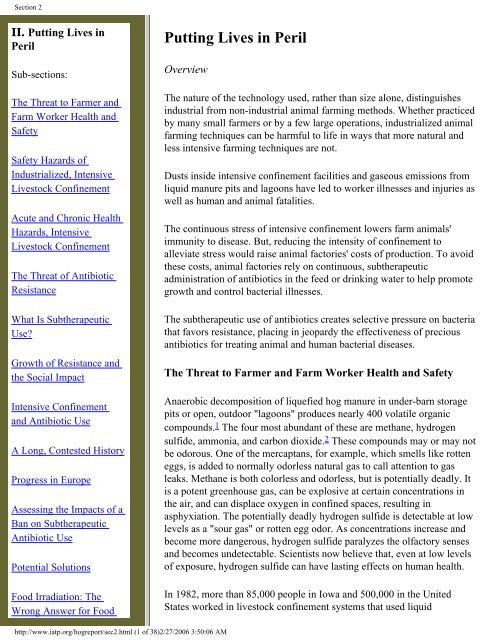IATP Hog Report - Institute for Agriculture and Trade Policy
IATP Hog Report - Institute for Agriculture and Trade Policy
IATP Hog Report - Institute for Agriculture and Trade Policy
You also want an ePaper? Increase the reach of your titles
YUMPU automatically turns print PDFs into web optimized ePapers that Google loves.
Section 2<br />
II. Putting Lives in<br />
Peril<br />
Sub-sections:<br />
The Threat to Farmer <strong>and</strong><br />
Farm Worker Health <strong>and</strong><br />
Safety<br />
Safety Hazards of<br />
Industrialized, Intensive<br />
Livestock Confinement<br />
Acute <strong>and</strong> Chronic Health<br />
Hazards, Intensive<br />
Livestock Confinement<br />
The Threat of Antibiotic<br />
Resistance<br />
What Is Subtherapeutic<br />
Use?<br />
Growth of Resistance <strong>and</strong><br />
the Social Impact<br />
Intensive Confinement<br />
<strong>and</strong> Antibiotic Use<br />
A Long, Contested History<br />
Progress in Europe<br />
Assessing the Impacts of a<br />
Ban on Subtherapeutic<br />
Antibiotic Use<br />
Potential Solutions<br />
Food Irradiation: The<br />
Wrong Answer <strong>for</strong> Food<br />
Putting Lives in Peril<br />
Overview<br />
The nature of the technology used, rather than size alone, distinguishes<br />
industrial from non-industrial animal farming methods. Whether practiced<br />
by many small farmers or by a few large operations, industrialized animal<br />
farming techniques can be harmful to life in ways that more natural <strong>and</strong><br />
less intensive farming techniques are not.<br />
Dusts inside intensive confinement facilities <strong>and</strong> gaseous emissions from<br />
liquid manure pits <strong>and</strong> lagoons have led to worker illnesses <strong>and</strong> injuries as<br />
well as human <strong>and</strong> animal fatalities.<br />
The continuous stress of intensive confinement lowers farm animals'<br />
immunity to disease. But, reducing the intensity of confinement to<br />
alleviate stress would raise animal factories' costs of production. To avoid<br />
these costs, animal factories rely on continuous, subtherapeutic<br />
administration of antibiotics in the feed or drinking water to help promote<br />
growth <strong>and</strong> control bacterial illnesses.<br />
The subtherapeutic use of antibiotics creates selective pressure on bacteria<br />
that favors resistance, placing in jeopardy the effectiveness of precious<br />
antibiotics <strong>for</strong> treating animal <strong>and</strong> human bacterial diseases.<br />
The Threat to Farmer <strong>and</strong> Farm Worker Health <strong>and</strong> Safety<br />
Anaerobic decomposition of liquefied hog manure in under-barn storage<br />
pits or open, outdoor "lagoons" produces nearly 400 volatile organic<br />
compounds. 1 The four most abundant of these are methane, hydrogen<br />
sulfide, ammonia, <strong>and</strong> carbon dioxide. 2 These compounds may or may not<br />
be odorous. One of the mercaptans, <strong>for</strong> example, which smells like rotten<br />
eggs, is added to normally odorless natural gas to call attention to gas<br />
leaks. Methane is both colorless <strong>and</strong> odorless, but is potentially deadly. It<br />
is a potent greenhouse gas, can be explosive at certain concentrations in<br />
the air, <strong>and</strong> can displace oxygen in confined spaces, resulting in<br />
asphyxiation. The potentially deadly hydrogen sulfide is detectable at low<br />
levels as a "sour gas" or rotten egg odor. As concentrations increase <strong>and</strong><br />
become more dangerous, hydrogen sulfide paralyzes the olfactory senses<br />
<strong>and</strong> becomes undetectable. Scientists now believe that, even at low levels<br />
of exposure, hydrogen sulfide can have lasting effects on human health.<br />
In 1982, more than 85,000 people in Iowa <strong>and</strong> 500,000 in the United<br />
States worked in livestock confinement systems that used liquid<br />
http://www.iatp.org/hogreport/sec2.html (1 of 38)2/27/2006 3:50:06 AM

















